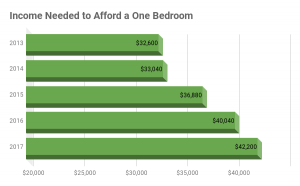By Sydney Boles
Medill Reports
A new report by the National Low Income Housing Coalition shows that affordable housing is further out of reach for minimum wage workers in Chicago than it was in 2015.
Someone working at the Chicago minimum wage would have to work 1.6 full-time jobs to afford a one-bedroom apartment, up from 1.3 in 2015. In other words, if a minimum wage worker had only one full-time job, they could reasonably afford just $572 in rent, slightly more than half the cost of the average Chicago apartment.
Research from the Institute for Housing Studies at DePaul University also shows that in Cook County in 2017, 53 percent of renter households paid more than 30 percent of their income to rent, qualifying them as rent-burdened.
“This is part of the affordable rental crisis that we’re having across the country,” said Sue Popkin, senior fellow at the Metropolitan Housing and Communities Policy Center and director of the Program on Neighborhoods and Youth Development at the Urban Institute. “The costs for rentals have been going up steadily and there’s been no production of affordable rental housing, and very little production of what they call multi-family housing, apartment buildings.”


Unsurprisingly, housing is more expensive in Chicago than other areas of the state. For instance, in the Quad Cities of northwest Illinois and southeast Iowa, the gap between what a minimum wage worker can afford and the cost of a modest apartment was much smaller. Someone working a minimum wage job would need to work 44 fewer hours per week to afford an average one-bedroom in Moline than the same worker making the same wage in Chicago.
Popkin, who has studied Chicago’s housing market extensively, was quick to note that Chicago was much more affordable than other metropolises like New York City and Los Angeles. But some data crunching reveals that while housing may be more expensive in New York City (a one-bedroom apartment would run you $1,419 in 2017), Chicago was getting more expensive faster. Between 2015 and 2017, the cost of a one-bedroom rose by 13.61 percent in New York and 14.42 percent in Chicago.
Housing Choice Vouchers, widely known as Section 8 vouchers, from the U.S. Department of Housing and Urban Development can help fill the gap between what renters can afford and what apartments cost. Recipients pay 30 percent of their income and their voucher covers the rest.
But as Chicago gains higher-earning workers, the area median income (AMI) rises, and so does the cutoff for receiving housing benefits like Section 8 vouchers. With a bigger pool of applicants, any one person will have a harder time receiving benefits.
Chicagoans who do qualify for vouchers find themselves on apartment waiting lists as long as 14 months, and the waiting lists for most housing programs are closed.
Popkin said that the affordable housing shortage is not the fault of the Chicago Housing Authority, which oversees the voucher program. Rather, the blame lies with the allocation of federal money. “They can only issue the subsidies they have funding to issue,” she said.
Politicians in Chicago and Springfield have tried to address the affordability gap. After a political brawl at the state level this August, Gov. Bruce Rauner vetoed a bill that would have raised the minimum wage to $15 per hour by 2022. But Chicago Mayor Rahm Emanuel’s December 2014 ordinance raised the city’s minimum wage to $11 an hour, on its way up to $13 by 2019, a move that is already helping 410,000 Chicagoans make ends meet.


